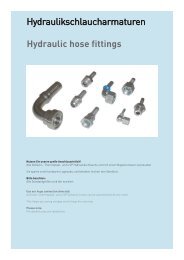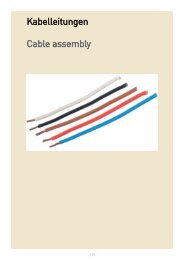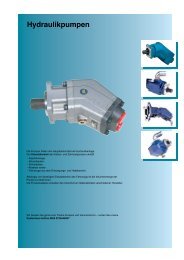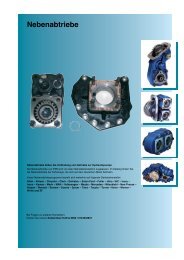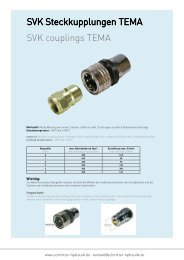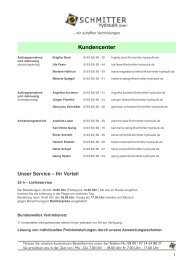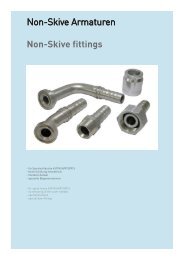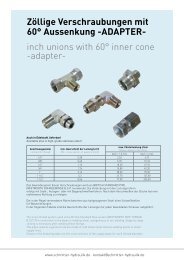Thermoplastic hoses and ferrules - Schmitter Hydraulik GmbH
Thermoplastic hoses and ferrules - Schmitter Hydraulik GmbH
Thermoplastic hoses and ferrules - Schmitter Hydraulik GmbH
You also want an ePaper? Increase the reach of your titles
YUMPU automatically turns print PDFs into web optimized ePapers that Google loves.
Trennen eines Zwillingsschlauchs seperating twin <strong>hoses</strong><br />
Trennen eines Zwillingsschlauchs<br />
Die folgenden Punkte und die Abbildung beschreiben die sachgerechte Trennung eines Zwillingsschlauchs:<br />
1. Den Schlauch so befestigen, dass die Trennung einfach durchgeführt werden kann;<br />
2. Einen Draht mit scharfem Profil aus Polyester oder Nylon verwenden;<br />
3. Den Draht am Verbindungspunkt der beiden Schläuche anlegen;<br />
4. Die Zwillingsschläuche jetzt durch eine Sägebewegung mittels des Drahtes trennen;<br />
Der Draht sollte dabei genau in der Mitte der Verbindung geführt werden;<br />
5. Die Zwilingsschläuche bis zum festgelegten Punkt trennen;<br />
6. Um zu vermeiden, dass sich die Zwillingsschläuche unter Einwirkung von Erschütterungen und/oder <strong>and</strong>eren mechanischen Belastungen<br />
über den festgelegten Punkt hinaus trennen, ist eine Schelle am Trennungsendpunkt des Zwillingsschlauchs anzubringen;<br />
7. Jetzt ist der Zwillingsschlauch anschlussbereit.<br />
Überprüfung des korrekten Trennens<br />
Sofort nach dem Trennen der Schläuche ist zu überprüfen, ob die Außendecke unbeschädigt ist. Sollte die Außendecke beim Trennen der<br />
Schläuche bis auf das Geflecht verletzt worden sein, ist das beschädigte Stück abzuschneiden und der oben beschriebene Vorgang zu wiederholen,<br />
um ein Platzen der <strong>Hydraulik</strong>leitung während des Betriebs zu vermeiden.<br />
Seperating twin <strong>hoses</strong><br />
Together with the diagram, the following points describe the correct procedure for seperating twin <strong>hoses</strong>:<br />
1. Securely fix the hose, in a position so that cutting can be carried out;<br />
2. Use a narrow but strong polyester or nylon thread;<br />
3. Line up the thread with the join between the two <strong>hoses</strong>;<br />
4. With a sawing action of the thread, the <strong>hoses</strong> can be seperated.<br />
Try to always keep the thread exactly in the middle of the connection between the two <strong>hoses</strong>;<br />
5. Seperate the <strong>hoses</strong> back to the desired point;<br />
6. To avoid the <strong>hoses</strong> from seperating over the desired point, due to either shaking or other mechanical damage it is better to use a shaped<br />
clamp for this purpose<br />
7. The twin hose is now ready for fitting the connectors<br />
Checking that the seperation is correct<br />
Immediately after seperating the <strong>hoses</strong>, check that the outer surface of the <strong>hoses</strong> are not damaged. If there is any damage to the outer surface<br />
so that the braid is exposed or even damaged, then it is better to discard the damaged section of the hose, <strong>and</strong> to repeat the procedure<br />
described above. This will minimise the possibility of a burst in the system during service.<br />
<strong>Schmitter</strong> <strong>Hydraulik</strong> <strong>GmbH</strong> · 97450 Arnstein · Tel.: +49(0)9363/60-0 · Fax: 60-14



